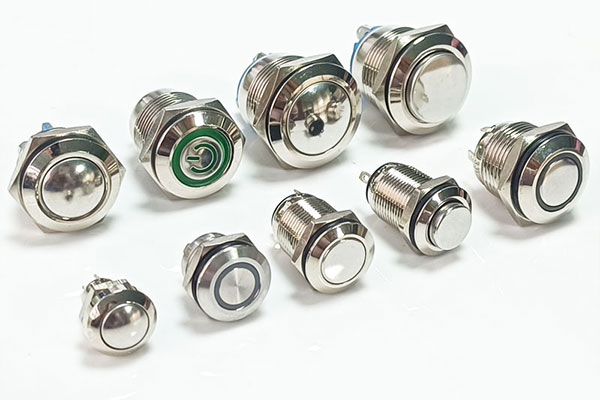Knowledge
What is the material of the metal push button switch?
Metal pushbutton switches are designed for durability and resilience, and the choice of materials plays a critical role in their performance. Here’s a detailed look at the materials typically used in metal pushbutton switches, focusing on the main components: the housing, actuator, contacts, and seals.

1. Housing
The housing of a metal pushbutton switch is typically made from the following materials:
Stainless Steel: Known for its corrosion resistance, strength, and longevity, stainless steel is a common choice for pushbutton switch housings. It can withstand harsh environments and mechanical stress, making it ideal for industrial applications.
Brass: Often plated with chrome or nickel, brass provides a sturdy and corrosion-resistant housing. The plating enhances its durability and gives it an attractive finish.
Aluminum: Lightweight and corrosion-resistant, aluminum is used in applications where weight is a concern. It can also be anodized to improve its resistance to wear and corrosion.
2. Actuator
The actuator, or the part of the switch that is pressed, is generally made from materials similar to the housing but may also include:
Stainless Steel: Provides a consistent look and feel with the housing and offers excellent durability and resistance to corrosion.
Aluminum: Used for its lightweight properties and often anodized for added protection and aesthetic appeal.
Plastic: High-quality plastics such as polycarbonate or ABS (Acrylonitrile Butadiene Styrene) can be used for the actuator, especially in switches where tactile feedback is important. These plastics are durable and can be molded into various shapes and designs.
3. Contacts
The contacts inside the pushbutton switch are crucial for its electrical performance. Common materials include:
Silver: Silver is widely used for contacts due to its excellent electrical conductivity and low contact resistance. However, it can tarnish over time, which can affect performance in some environments.
Gold: Gold-plated contacts are often used in applications requiring reliable, low-resistance connections and minimal corrosion. Gold does not tarnish, ensuring long-term performance.
Copper Alloys: Copper and its alloys, such as brass and bronze, offer good conductivity and mechanical strength. They are often used as a base material with a plating of silver or gold to enhance performance.
4. Seals and Gaskets
Seals and gaskets are used to provide environmental protection, ensuring the switch is dustproof and waterproof to various degrees (e.g., IP65, IP67 ratings). Common materials include:
Silicone Rubber: Provides excellent flexibility, durability, and resistance to extreme temperatures. Silicone is often used for gaskets and O-rings in pushbutton switches.
EPDM (Ethylene Propylene Diene Monomer): Known for its resistance to weathering, ozone, and UV exposure, EPDM is another popular choice for seals in pushbutton switches.
5. Backing and Mounting Components
The backing and mounting components, which secure the switch to the panel, are typically made from:
Stainless Steel or Brass: These materials offer strength and corrosion resistance, ensuring the switch remains securely mounted and operational over time.
Plastic: High-strength plastics can also be used, providing a lightweight alternative with good durability.
The materials used in metal pushbutton switches are selected based on their properties to meet the demands of various applications. Stainless steel, brass, and aluminum provide robust housings, while silver, gold, and copper alloys ensure excellent electrical performance for contacts. Seals made from silicone rubber and EPDM offer environmental protection, enhancing the switch's reliability and longevity. Understanding these materials helps in selecting the right pushbutton switch for specific applications, ensuring optimal performance and durability.
RELATED NEWS
- Types of Anti-Vandal Switches 2025-02-28
- Where Are Anti-Vandal Switches Used 2025-02-27
- The tact switch with integrated LED for illumination vision 2025-02-27
- Introduction to LED Tact Switches 2025-02-18
- An Article For Emergency Stop Push Button 2025-02-11
CATEGORIES
LATEST NEWS
CONTACT US
Contact: Bella
Phone: 15999819066
E-mail: rucoe@rucoe.com
Whatsapp:+86-15999819066
Add: Taoyuan Street, Nanshan, Shenzhen
